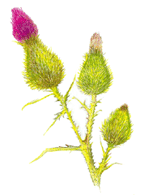
Burdock
Introduction
This fact sheet provides basic information about Burdock. Budock is considered to be native in Europe and Northern Asia; it is naturalized in the US. Burdock is widely cultivated in Eastern Europe especially former Yugoslavia, Poland, Bulgaria and Hungary. The plant is a perennial or biennial herb.
Common Names
Burdock, Bardana, Beggar's Buttons, Clotbur, Edible Burdock, Great Bur, Great Burdocks, Lappa, Bur Oil
Latin Names
Arctium lappa
What It Is Used For
- Colds
- Catarrh
- Gout
- Rheumatism
- Stomach ailments
- As a diuretic, diaphoretic and laxative.
- Externally, it has been used for various skin problems, such as acne, eczema, rosacea and psoriasis.
- Burdock root oil extract, also called Bur oil, is popular in Europe as a scalp treatment applied to improve hair strength, shine and body, help reverse scalp conditions such as dandruff, and combat hair loss.
How It Is Used
In traditional medicine, the fruits, seeds, roots and leaves of burdock have been used as decoctions or teas.
What the Science Says
- It should be noted that burdock root is fairly commonly used as a food in Asia.
- Several researchers have reported on the various biological activities of burdock which include antipyretic, antimicrobial, antitumor, diuretic, and diaphoretic properties.
Side Effects and Cautions
- Burdock is generally considered a safe and edible food product. A few reports have appeared on burdock root tea poisoning (blurred vision, headache, drowsiness, slurred speech, loss of coordination, incoherent speech, restlessness, hallucinations, hyperactivity, seizures, disorientation, flushing, dryness of mouth and nose, rash, lack of sweating, fever) due to adulteration with atropine-containing plants.
Sources







